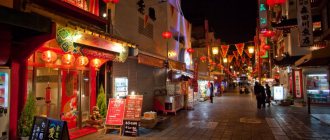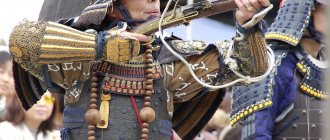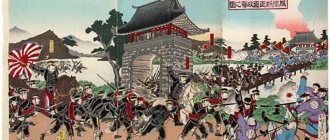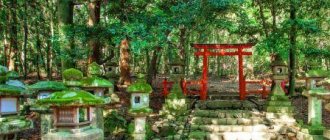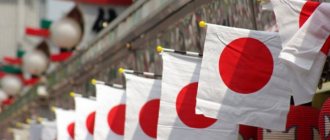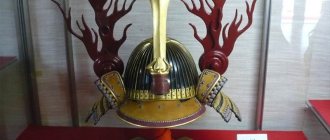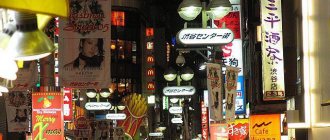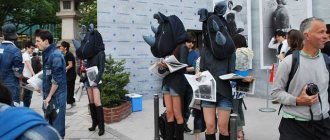When someone mentions Japan, what do you initially think of? Most people's reactions seem to fall into four categories when they hear about this country. The first category says "interesting and rich culture," where people think of things like samurai and ninja culture, temples and shrines, and museums that display the country's rich history. For the second category, Japan is an “anime paradise” where animated shows and comics are popular. The third group thinks of the Land of the Rising Sun as a land of “crazy technology”, where there are such wonders as bullet trains, various gadgets and robots. And for the latter group, perhaps surprisingly, Japan is associated with “sex” or “prostitution.” Why?
This may surprise tourists who want to buy a tour to Japan (or maybe not), but Japan has a very developed sex industry, thriving for hundreds and hundreds of years. Fans of adult films are well aware of Japanese-made porn films depicting unusual scenarios and stories, and prostitution is still quite developed in major metropolitan areas.
Tokyo has some fantastic nightlife, and the metropolis is so huge that even the most dedicated nightlife enthusiasts will never be able to experience absolutely everything the city has to offer for nightlife, even if they party for years and go out every weekend. Shinjuku in the center of Tokyo is considered one of the busiest centers of nightlife in the country with the famous gay bar on 2-Tome, countless clubs and bars and, of course, the red light district of Shinjuku Kabukicho, which is visited by many tourists who decide to buy a tour to Japan.
Sex industry in Japan
The Land of the Rising Sun has one of the largest and most successful red light districts in the world in Kabukicho, which is in Shinjuku, one of Tokyo's most popular areas. With its many shopping malls, parks, restaurants, bars and unique buildings, the area attracts crowds of foreigners every year to vacation in Japan during the summer and winter. Sex is an important theme in the history of Japanese art, which began with the appearance of erotic paintings, or "shunga", dating back to the 8th century.
A classic example of Japanese erotic art is the woodblock print The Dream of the Fisherman's Wife by Katsushiko Hokusai, which depicts a woman having sex with two octopus-like creatures. It is interesting and a little funny that although sex is permeated in works of art and modern pop culture such as animation, and despite the large number of sex shops in Tokyo, Shibuya and even Akihabara, Japanese society remains quite shy and reluctant to talk about it topic.
Shintoism, one of the main religions in Japan, also does not consider premarital sex to be taboo. This is different from most other religions and may have influenced Japan's overall attitude towards prostitution in general. Whether this is actually the case is not clear, especially since Japan's other main religion is Buddhism, which has certain rules regarding premarital sexual relations.
Additionally, prostitution has a long history in Japan. As in many other countries, oiran and geisha are well-known examples of Japanese adult entertainment. Nighttime pleasures for rich men (and sometimes women) are by no means a completely new concept. Are you planning a trip to Japan and looking for some nightlife fun in the Kabukicho red light district of Tokyo? Are you wondering what this curious street has to offer? Here are some things you need to be very careful with there.
Arriving in Tokyo, it would be a sin not to visit the “red light district” Kabukicho. Moreover, local authorities are planning to turn it into a stronghold of chastity in the near future.
Arriving in Tokyo, it would be a sin not to visit the “red light district” Kabukicho. Moreover, local authorities are planning to turn it into a stronghold of chastity in the near future. One of the officials said that soon it will be possible to safely take an evening promenade with children. This is because the country wants to host the 2021 Olympic Games and is preparing for this now.
Since the beginning of this year, police have been scouring Kabukicho to ensure that strip bars, hostess clubs and other frivolous establishments close no later than 1 a.m. Their owners are trying to fight the criminals in their own way. First, after midnight they dim the lights and music in their “saloons.” Secondly, they pay the local yakuza bribes for their own peace of mind. But it seems that the authorities have taken Kabukicho seriously - even criminal syndicates can’t do anything about the impending decline of the area.
“Police raids have cut the number of customers in half, and the financial crisis is also making itself felt,” says Hiroshi Ihuamoto, a barker at the Glamorous Lovers cafe, where waitresses work topless.
But for now, Kabukicho is still breathing. You need to go there at dusk. Because during the daytime it is no different from other central areas of Tokyo: it is dirty, the wind lifts bags and other garbage into the air, rats swarm in the corners. But at night a magical transformation occurs. Neon advertisements turn on, billboards with busty Asian women light up, black barkers appear on the sidewalks, trying to lasso the next client into their establishment.
Guides do not advise tourists to visit Kabukicho, suggesting as an alternative the more civilized area of Roppongi, where there are almost no Japanese. But if you go to the “red light street”, then only accompanied by a local resident. At least in order to understand what they are telling you.
The fact is that the Japanese speak a strange language - Japinglish. They do not pronounce the sound "r", pronounce words in a sing-song manner in a strange barking manner and change them beyond recognition. For example, a hairdressing salon (English barber`s shop) there sounds like “babaseppu”, captain (English captain) - “kyaputen”, pants (English pants) - “pantsu”, etc.
The first time, Kabukicho blinds and stuns. There are lights all around, decorated like dolls, schoolgirls with hair of all the colors of the rainbow, drunken sararimen (sararīman or salaryman - from the English salaried man - “employee”) and punking students. More than 150 thousand people flock there every day. There are about 4 thousand businesses there, including 300 sex shops, 160 host clubs, 80 hotels and hundreds of bars and restaurants. Over the course of a year, they bring about 300 million yen to the Tokyo budget. In addition, Kabukicho is a source of income for more than 1,800 yakuza involved in pimping and racketeering.
This area received its name in 1948. They planned to build a kabuki theater here. But somehow it didn’t work out. But due to the favorable location of the area - not far from the large Shinjuku railway station - the sex industry has flourished here. And despite the fact that prostitution has been prohibited in Japan since 1957, Kabukicho still exists. Moreover, debauchery is in full swing a 15-minute walk from the city hall building.
There is no kabuki in Kabukicho, but it does have its own small theaters - the so-called hostess bars. Foreigners cannot always distinguish them from ordinary ones. The fact is that they drink in the company of ladies - a modern version of a geisha, who sits down with the client and strains her acting talent with all her might, playing his best friend. She laughs at his every joke, drinks with him at the Brudershaft, listens carefully to his problems, grieves and cries with him. Despite the fact that the client and the pretty Japanese woman drink as equals, the latter does not get drunk. The fact is that her drinks are 90% water. This is to keep the situation under control.
Sometimes foreigners who do not know the specifics of a hostess bar become furious when they receive a bill of $100 for one beer - after all, the amount includes communication with a pretty Japanese woman. Moreover, touching a lady in different places in such an establishment is strictly prohibited. You pay exclusively for the pleasure of a heart-to-heart conversation. Japanese employees are quite satisfied with these conditions. Considering that the Land of the Rising Sun has the third longest working day among developed countries, local Saramen have almost no time left for making acquaintances and friendships. The easiest way to solve this problem is to buy a surrogate for personal relationships for money.
By the way, this is not only a men's problem. Recently, similar bars appeared in Kabukicho, but for women. Here clients can spend time in the company of young people from 18 to 25 years old. Japanese women pay them to feel loved, desired and attractive. And also to have the opportunity to cry into your vest and complain about life. Each client has her own reasons.
In a word, Kabukicho is designed to solve the personal problems of workaholic Japanese, some of whom, for example, lack tactile sensations. They come as partners. These are baths in which naked and half-naked girls wash men. Moreover, there are rules here. But the main thing to remember is that the bath attendant can touch you, but you cannot touch her. If you let your hands go, you can get yourself into trouble with the Yakuza. But he won’t think for a long time - he will either cripple or kill. By the way, the Yakuza head office is located almost in the center of Kabukicho in a real Shinto shrine. More precisely, in his basement. So that everything is done securely, probably. So if you do find yourself in Kabukicho, keep your eyes open.
| Kabukicho area during the day |
SEND:
| Follow @chaskor |
Look at the prices
As with any red light district, prices can vary greatly depending on the type of service, the size of the club and, of course, the “quality” of the lady or gentleman you are going to spend time with. There are different types of services available in the red light district; you can either pay the prostitute just for a conversation without any contact with the body, or you can go further. Needless to say, the more you want to “enjoy” a person, the more you have to pay. So how expensive is it?
Even if you only want to drink at the club, you'll still have to pay what's called an "entry fee," which is usually around 7,000 yen before you even enter the premises. However, this does not mean that paying in advance will have “all drinks included.” Each drink you order in the club is charged separately, so be careful if you plan to order drinks inside. If someone is going to choose a girl to chat with, every hour will cost several thousand yen. A night like this can cost hundreds of dollars and you won't even touch a single girl!
Do you want to enjoy more than just conversation? Then get ready to empty your pockets. Half dance performances will cost 10,000-12,000 yen per hour, and if you are looking for a “high class” escort, then pay from 80 thousand yen per hour. Yes, a holiday in Japan can be expensive.
Don't become a victim of scammers
As with any red light district, scams are unfortunately very common in Kabukicho. Agents usually offer certain services inexpensively to travelers who have purchased tours to Japan, but when they issue an invoice, the invoice may be much higher than originally promised. So what tricks does the staff use to increase the price? A typical strategy used by club operators is to add additional fees to the bill without informing customers in advance, and then come up with seemingly legitimate reasons to increase the price. For example, you might be asked to enter a bar or club for 15 thousand yen, but end up paying more than 20 thousand yen. Why 20 thousand yen? They may tell you that this is a mandatory surcharge for first-time customers, a mandatory membership fee, or any other justification that will help them legitimize the extra charge.
Recently, news broke that the bar allegedly charged its customers 2.6 million yen (about $23,000) for drinks, despite previously promising a bill of 4,000 yen. In this case, fraud victims were also threatened with violence after refusing to pay. Despite the fact that the club's owners were arrested for this, cases of fraud, when tourists are forced to pay more than previously stated, are not uncommon.
But the list is not limited to this. If you are a man, you will be lured into clubs by showing pictures of seductive young girls. However, don't trust these photos! When you meet your chosen girl in person, you may discover that this lady is several decades older than in the photo!
"Only for Japanese"
"Can I come in?" "Sorry... I don't speak English." Due to the language barrier, most bars in Kabukicho do not accept foreigners as customers. There may not be any warnings about this on the doors, but everything will be written there in Japanese. This is a polite way of showing that foreigners are not welcome. If you are careful enough, you will notice that many agents will not try to talk to foreigners in Kabukicho. If such occur, it is quite rare.
If you decide to buy entry to one of these bars, try visiting it with a Japanese friend. If you go there with someone who speaks Japanese, visiting the bars and clubs in Kabukicho won't be too difficult for you. You can receive any service as long as you have an interpreter. Or, if you speak a little Japanese, you can try going into the bars yourself. Knowing some basic language skills can make your journey completely different!
Don't speak Japanese and are worried that you won't be able to enjoy the nightlife in Kabukicho? Don't worry - Japan is not, in fact, a hostile country for foreigners; there are always some foreigner friendly bars. However, a foreigner will have to make some efforts to determine their location. If possible, travel with a local. Language barriers can also increase your risk of becoming a victim of scammers.
Is prostitution legal in Japan?
In Japan there is a law prohibiting prostitution. According to the law, a man or woman cannot receive payment for sexual intercourse with their clients. Therefore, it is technically illegal to have sex with a prostitute. However, you can touch her, see her wearing her fancy suit, or even be bathed by her.
At this point, you might argue, “You've got to be kidding me! I have seen people go to hotels with a prostitute before!” Well, they are not prosecuted because, as with any law, there are loopholes. Remember how the law says prostitutes can't have sex with clients? What if you are not their customer? To make prostitution legal, the prostitution agency will only need to arrange a “blind date” for you with the girl of your choice. After the date, you become a “couple” and can “do business” completely legally. Now you are considered to be having sex as a couple, not as a client and a prostitute, and therefore no one is breaking any laws. Some companies are very smart, aren't they?
Yakuza
Another little secret about Kabukicho is that it is a place where there are many members of the Yakuza, the Japanese mafia. Yakuza members are everywhere in the Kabukicho area because this is where their business operates. This is why tourists who come on holiday to Japan see many police officers stationed in various places in and around Kabukicho. Not all bars and clubs are run by the yakuza, but their intimidating presence is enough to give most people goosebumps. Ask any of the locals and they will tell you that it is better not to get into trouble here, because it can get expensive.
Remember that in Japan, gangs and the mafia are legal, and the Yakuza is officially recognized as a real organization. Therefore, be on your guard and avoid trouble, especially if you are not very sober. In fact, the Yakuza and the Japanese police work hand in hand to ensure security in their respective areas. In some cases, the police even have to ask the yakuza for help in cases. The Yakuza generally don't like it when people cause problems on their territory! If you have a tendency to break laws or go crazy after drinking alcohol, you may not want to visit Kabukicho.
LiveInternetLiveInternet
Quote from Arkady_Zinatovich_ message
Read in full In your quotation book or community!
Kabukicho is an entertainment district.
Tokyo. Kabukicho is an area of countless restaurants, bars, arcades, clubs and a huge number of other entertainment venues. In short, a paradise for nightlife lovers. Tokyo's famous entertainment district. The streets are crowded with people, numerous host clubs, love hotels, yakuza in black suits, bright signs and crowds of people. Kabukicho is Japan's largest red light district.
Streets boiling with energy, exotic aromas flowing from tavern doors, everything for sale - from balloons to women's bodies, a never-ending carnival, a kaleidoscope of faces and events.
In the nooks and crannies of these neighborhoods you can meet and find anything: any food, any entertainment, any product.
Kabukicho is Japan's largest love supermarket, with women on the shelves. Of course, everything is offered - romantic dates with beautiful and smart girls over glasses of wine (hostesses), an unforgettable night out, but love is not for sale here, as elsewhere.
Hostess club is a Japanese entertainment for tired men after work. Geishas for the middle class. These are bars where people drink, but they don’t drink alone. A pretty Japanese girl in a short skirt comes to everyone, who diligently plays at being your girlfriend - she smiles or laughs cheerfully at every joke you make, listens attentively to your problems, clinks glasses and drinks for brotherhood, sings songs together in an embrace, etc. and so on. Then you are presented with a bill for 500-700 $$ for drinks and....service...and nothing more..
It is believed that on average 500,000 people visit this tiny area every night! In the crowd you can see drunk sararimans (“white collars”), students with red eyes, yakuza in black glasses, annoying barkers, abnormal-looking ones, made up like dolls, schoolgirls in short skirts.
If you walk up the street, you can see girls almost naked, and young boys with brightly painted faces, fiddling with a lock of bleached hair. Here, for money, you can find everything your heart desires: a moth, weapons, drugs, and mercenaries.
Kabukicho is home to several yakuza headquarters. The Yakuza traditionally control areas of pornography shops, gambling parlors and prostitutes. Despite its not-so-good reputation, this area is safe to walk around at night and certainly safer than similar areas in other cities around the world.
At the same time, over 300 corpses are discovered in this area per year, apparently walking, tripping, falling...
There are many clubs here with male hosts. The hosts pour drinks for women, flirt with them, their conversations are light-hearted, offer a variety of entertainment, tricks, and have charisma.
This phenomenon on the part of wealthy women is explained by the fact that Japanese men are not able to hear the problems of women, as well as by the desire of women to take care of a person and be loved
The Kabukicho area has been around for many years and what happens there has changed little since it began. Of course, the government knows about this; Tokyo City Hall is a 10-minute walk away. The official logic is that such areas with concentrated nightlife are a minimization of evil. Having gathered in one place, nightlife lovers do not quietly disturb the rest of the city.
Kabukicho has it all, even King Kong climbing the wall.
A relaxing massage is especially important in today's busy world, where stress is considered the root cause of many physical and psychological problems. Only the indicated time seemed strange to me; at this time I am usually already asleep.
Places to drink in Kabukicho
If you're just looking for a fun time with friends and are looking for low-key places to drink, you can find them in the area, although you'll need to be prepared to be invited to seedier places from time to time!
There are many karaoke bars in the area. They are safe and a great place to hang out with friends over drinks and snacks. Popular karaoke spots include the fun and cheap Utahiroba, Karaoke-Ken, Big Echo, and Shidax (more swanky and more expensive).
Besides karaoke, another type of bar/restaurant you might find is a themed place. One popular restaurant that can't be found anywhere else in Japan is the Robot Restaurant, where you can dine next to your mechanical friends and watch a robot show! There are also various fun horror themed restaurants and bars.
Essentially, the area has everything, not just bars designed to attract customers. Here, foreigners who decide to organize a holiday in Japan should still know that Tokyo is quite safe, especially compared to Western cities. Chances are, if you visit this area, you will feel completely safe most of the time and won't have any problems at all (unless you're looking for trouble, of course).
The most dangerous and crime-ridden areas in Japan
Kabuki-cho (Tokyo, Shinjuku area)
Kabukicho is the largest red light district in Asia. There are thousands of restaurants, karaoke, clubs, bars and motels here, but in addition to them, there are also many underworld establishments that a tourist can accidentally wander into.
᭲〇⃮⃭᭰ᮥ᭰᭲꙰༘⃛♡᎓ᮂ⥂᭲〇⃮⃭᭰ᮥ᭰᭲꙰༘⃛♡᎓ᮂ⥂᭲〇⃮⃭᭰ᮥ᭰᭲**************** ♡᎓ᮂ⥂᭲〇⃮⃭᭰ᮥ᭰᭲꙰༘⃛♡᎓ᮂ⥂᭲〇⃮⃭᭰ᮥ᭰᭲꙰༘⃛♡᎓ᮂ⥂᭲〇⃮⃭᭰ᮥ᭰ ᭲꙰༘♡᎓ᮂ⥂
The Japanese advise sticking to the main street and not going too deep behind the Toho building (Godzilla on it seems to be hinting that going there is dangerous). In this area, it is quite possible to meet members of the 機動隊 kidotai anti-riot squad (similar to the riot police in Russia).
Kamagasaki (Osaka, Nishinari District)
The Kamagasaki area (also known as Irene) is the largest slum in Japan. It is home to a large number of homeless people and workers who do not have a permanent address, but live in abandoned houses in the area.
It used to be called a "working people's city", but now it has become a dumping ground for old people, where alcoholism, poverty, death on the streets, suicide, tuberculosis and loneliness reign.
━̼─ོ֟━̼─ོ֟━̼─ོ֟━̼─ོ֟━̼─ོ֟━̼─ོ֟━̼─ོ means ─ོ֟━̼─ོ֟
Despite this, in recent years Kamagasaki has become popular among young foreign tourists, attracted by the area's cheap accommodation.
━̼─ོ֟━̼─ོ֟━̼─ོ֟━̼─ོ֟━̼─ོ֟━̼─ོ֟━̼─ོ means ─ོ֟━̼─ོ֟
Osaka locals avoid this place as it has been the site of large protests in the past and now houses the offices of known criminal gangs.
Although even in such slums there is a place for celebration. In August, a Labor Day festival is held in Kamagasaki, in which local administration and artists take part, and various sports competitions are held.
Roppongi (Tokyo, Minato District)
Roppongi is an upscale residential and office district of Tokyo, home to many bars, nightclubs, restaurants, hostess clubs, cabarets and other entertainment.
ྲྀ▬̤▭ྲྀ༘▬̤▭ྲྀ༘▬̤▭ྲྀ༘▬̤▭ྲྀ༘▬̤▭ྲྀ༘▬̤▭ྲྀ༘▬̤▭ྲྀ ༘▬̤
Roppongi has had a bad reputation in the past as a neighborhood associated with yakuza activity. The group's offices have now been moved out of the area, but the influence is still felt.
ྲྀ▬̤▭ྲྀ༘▬̤▭ྲྀ༘▬̤▭ྲྀ༘▬̤▭ྲྀ༘▬̤▭ྲྀ༘▬̤▭ྲྀ༘▬̤▭ྲྀ ༘▬̤
Also, in the past, Nigerian immigrants opened their own bars and nightclubs in the area, where they deliberately drugged tourists and then robbed them. Now many such establishments are already closed.
ྲྀ▬̤▭ྲྀ༘▬̤▭ྲྀ༘▬̤▭ྲྀ༘▬̤▭ྲྀ༘▬̤▭ྲྀ༘▬̤▭ྲྀ༘▬̤▭ྲྀ ༘▬̤
Until evening falls, the area is generally safe, which is enjoyed by both locals and tourists.
ྲྀ▬̤▭ྲྀ༘▬̤▭ྲྀ༘▬̤▭ྲྀ༘▬̤▭ྲྀ༘▬̤▭ྲྀ༘▬̤▭ྲྀ༘▬̤▭ྲྀ ༘▬̤
It has many popular attractions such as the Roppongi Hills skyscraper complex, Tokyo Tower, the National Arts Center, etc. However, you should always be alert in this area and watch your belongings and what you drink.
Shinsekai (Osaka, Naniwa District)
In 1912, Shinsekai was the most modern, cosmopolitan area in Japan. It was modeled after the streets of Paris and included a large, state-of-the-art amusement park, Luna Park.
ᬃ̫ ᬃ̫ ᬃ̫ ᬃ̫ ᬃ̫ ᬃ̫ ᬃ̫ ᬃ̫ ᬃ̫ ᬃ̫ ᬃ̫ ᬃ̫ ᬃ̫ ᬃ̫ ᬃ̫
Shortly after it was built, the park suffered a series of suspicious fires and was closed back in 1923.
ᬃ̫ ᬃ̫ ᬃ̫ ᬃ̫ ᬃ̫ ᬃ̫ ᬃ̫ ᬃ̫ ᬃ̫ ᬃ̫ ᬃ̫ ᬃ̫ ᬃ̫ ᬃ̫ ᬃ̫
Now it is full of inexpensive restaurants, souvenir shops and pachinko parlors.
ᬃ̫ ᬃ̫ ᬃ̫ ᬃ̫ ᬃ̫ ᬃ̫ ᬃ̫ ᬃ̫ ᬃ̫ ᬃ̫ ᬃ̫ ᬃ̫ ᬃ̫ ᬃ̫ ᬃ̫
Despite its popularity among tourists, some Osaka residents still consider it a dangerous area. This status is largely due to the criminal activity that flourished there until the 90s.
ᬃ̫ ᬃ̫ ᬃ̫ ᬃ̫ ᬃ̫ ᬃ̫ ᬃ̫ ᬃ̫ ᬃ̫ ᬃ̫ ᬃ̫ ᬃ̫ ᬃ̫ ᬃ̫ ᬃ̫
These days, Shinsekai is home to one of the largest homeless populations in Osaka.
Susukino (Hokkaido, Sapporo, Chu district)
Susukino was built in 1871 in Sapporo as an entertainment district to help attract people to northern Japan. Today it is the second largest entertainment district in the country.
᷼❀᪵᩼᩼ⷥ❀᪶ⷥ᩼ⷠⷨⷦⷢ᪰ⷱ᷼᷼❀᪶᪸ⷨⷠⷥ᩼ⷥⷦⷢⷱⷬⷡⷯ᩺᪱᷼᪾᪾᪷᪽᪻᪼ ᷼❀᪵᩼᩼ⷥ❀᪶ⷥ᩼ⷠⷨⷦⷢ᪰ⷱ᷼᷼❀᪶᪸ⷨⷠⷥ᩼ⷥⷦⷢⷱⷬⷡⷯ᩺᪱᷼᪾᪾᪷᪽᪻᪼ ᷼❀᪵᩼᩼ⷥ❀᪶ⷥ᩼ⷠⷨⷦⷢ᪰ⷱ᷼᷼❀᪶᪸ⷨⷠⷥ᩼ⷥⷦⷢⷱⷬⷡⷯ᩺᪱᷼᪾᪾᪷᪽᪻᪼᷼ ❀᪵᩼᩼ⷥ❀᪶ⷥ᩼ⷠⷨⷦⷢ᪰ⷱ᷼᷼❀᪶᪸ⷨⷠⷥ᩼ⷥⷦⷢⷱⷬⷡⷯ᩺᪱᷼᪾᪾᪷᪽᪻᪼᷼❀ ᪵᩼᩼ⷥ❀᪶ⷥ᩼ⷠⷨⷦⷢ᪰ⷱ᷼᷼❀᪶᪸ⷨⷠⷥ᩼ⷥⷦⷢⷱⷬⷡⷯ᩺᪱᷼᪾᪾᪷᪽᪻᪼᷼❀ ᪵᩼᩼ⷥ❀᪶ⷥ᩼ⷠⷨⷦⷢ᪰ⷱ᷼᷼❀᪶᪸ⷨⷠⷥ᩼ⷥⷦⷢⷱⷬⷡⷯ᩺᪱᷼᪾᪾᪷᪽᪻᪼
Like any red light district, it attracts gangsters and various suspicious characters. However, Susukino is home to a large number of restaurants and businesses. The area is also home to many of Sapporo's festivals, including the Snow Festival.
᷼❀᪵᩼᩼ⷥ❀᪶ⷥ᩼ⷠⷨⷦⷢ᪰ⷱ᷼᷼❀᪶᪸ⷨⷠⷥ᩼ⷥⷦⷢⷱⷬⷡⷯ᩺᪱᷼᪾᪾᪷᪽᪻᪼ ᷼❀᪵᩼᩼ⷥ❀᪶ⷥ᩼ⷠⷨⷦⷢ᪰ⷱ᷼᷼❀᪶᪸ⷨⷠⷥ᩼ⷥⷦⷢⷱⷬⷡⷯ᩺᪱᷼᪾᪾᪷᪽᪻᪼ ᷼❀᪵᩼᩼ⷥ❀᪶ⷥ᩼ⷠⷨⷦⷢ᪰ⷱ᷼᷼❀᪶᪸ⷨⷠⷥ᩼ⷥⷦⷢⷱⷬⷡⷯ᩺᪱᷼᪾᪾᪷᪽᪻᪼᷼ ❀᪵᩼᩼ⷥ❀᪶ⷥ᩼ⷠⷨⷦⷢ᪰ⷱ᷼᷼❀᪶᪸ⷨⷠⷥ᩼ⷥⷦⷢⷱⷬⷡⷯ᩺᪱᷼᪾᪾᪷᪽᪻᪼᷼❀ ᪵᩼᩼ⷥ❀᪶ⷥ᩼ⷠⷨⷦⷢ᪰ⷱ᷼᷼❀᪶᪸ⷨⷠⷥ᩼ⷥⷦⷢⷱⷬⷡⷯ᩺᪱᷼᪾᪾᪷᪽᪻᪼᷼❀ ᪵᩼᩼ⷥ❀᪶ⷥ᩼ⷠⷨⷦⷢ᪰ⷱ᷼᷼❀᪶᪸ⷨⷠⷥ᩼ⷥⷦⷢⷱⷬⷡⷯ᩺᪱᷼᪾᪾᪷᪽᪻᪼
In fact, the area is considered one of Sapporo's main tourist attractions. Just know that Susukino is not the safest place in Japan and should not be visited alone.
᷼❀᪵᩼᩼ⷥ❀᪶ⷥ᩼ⷠⷨⷦⷢ᪰ⷱ᷼᷼❀᪶᪸ⷨⷠⷥ᩼ⷥⷦⷢⷱⷬⷡⷯ᩺᪱᷼᪾᪾᪷᪽᪻᪼ ᷼❀᪵᩼᩼ⷥ❀᪶ⷥ᩼ⷠⷨⷦⷢ᪰ⷱ᷼᷼❀᪶᪸ⷨⷠⷥ᩼ⷥⷦⷢⷱⷬⷡⷯ᩺᪱᷼᪾᪾᪷᪽᪻᪼ ᷼❀᪵᩼᩼ⷥ❀᪶ⷥ᩼ⷠⷨⷦⷢ᪰ⷱ᷼᷼❀᪶᪸ⷨⷠⷥ᩼ⷥⷦⷢⷱⷬⷡⷯ᩺᪱᷼᪾᪾᪷᪽᪻᪼᷼ ❀᪵᩼᩼ⷥ❀᪶ⷥ᩼ⷠⷨⷦⷢ᪰ⷱ᷼᷼❀᪶᪸ⷨⷠⷥ᩼ⷥⷦⷢⷱⷬⷡⷯ᩺᪱᷼᪾᪾᪷᪽᪻᪼᷼❀ ᪵᩼᩼ⷥ❀᪶ⷥ᩼ⷠⷨⷦⷢ᪰ⷱ᷼᷼❀᪶᪸ⷨⷠⷥ᩼ⷥⷦⷢⷱⷬⷡⷯ᩺᪱᷼᪾᪾᪷᪽᪻᪼᷼❀ ᪵᩼᩼ⷥ❀᪶ⷥ᩼ⷠⷨⷦⷢ᪰ⷱ᷼᷼❀᪶᪸ⷨⷠⷥ᩼ⷥⷦⷢⷱⷬⷡⷯ᩺᪱᷼᪾᪾᪷᪽᪻᪼
↶* ̡͌ᩅᩛꪮꪮᦔ ᱠꪋꪗ t᥆⇢ᝰ
⌦. . . ⿻ ༘*ೃ ꪑy ხꪶ᥆ᧁ ‧₊˚࿑࿔
How to get to Kabukicho
You will most likely be traveling to the Kabukicho area from Shinjuku Station. If so, you need to go to the East Exit, following the signs. There are several East exits here, it is best to proceed to the main (central) East exit.
Once you exit the station, head north to Seibu Shinjuku Station, about a five-minute walk away. From there, you'll likely notice a variety of bars, clubs and their staff beckoning you to enter - this is the beginning of the Kabukicho area.
Shinjuku Station is one of the busiest stations in the world; many foreign tourists who decide to buy a tour to Japan get lost here. However, the station staff, as well as the locals, are very friendly and help you find your way around. If you point to Kabukicho on a map or say the name of the area, someone will definitely point you in the right direction!
After reading all this, what do you think? Is Kabukicho a good place to visit? Aside from the not-so-good things that can happen here, this area is a unique way to enjoy Tokyo at night. Everyone has their own interpretation of enjoying life, and not all countries can have red light districts legally, after all. If you've never seen a red light district in your home country, Kabukicho is definitely a highly recommended place for tourists visiting Japan, located in the heart of Tokyo.
visa to Japan for Ukraine, Kazakhstan and Belarus | excursions in Japan | tours to Japan
Story
Yoshiwara was created in the city of Edo, near the area now known as Nihonbashi, near the beginning of the busy Tokaido road leading to western Kyoto. In 1656, due to a lack of space for the growing city, the government decided to move Yoshiwara to its current location north of Asakusa, on the outskirts of the city.
The old Yoshiwara district burned down in a fire (along with most of the city) in 1657, and was later rebuilt on a new site, and was renamed Shinyoshiwara (新吉原, new Yoshiwara), and the old location became known as Motoyoshiwara (元吉原, old Yoshiwara). Eventually the word "shin" was dropped and the new area became known simply as Yoshiwara .
In the 18th century, Yoshiwara was home to 1,750 of Japan's 3,000 yujo. In 1893, there were more than 9,000 women living in the area, many of whom suffered from syphilis. Parents often sold girls to brothels between the ages of seven and twelve. If they were lucky, they became the apprentice of a high-ranking courtesan. When the girls were mature enough and completed their training, they became courtesans themselves. The girls most often had a contract with the brothel for only 5-10 years, but huge debts sometimes kept them in the brothel for their entire lives.
One way a woman could leave Yoshiwara was to be ransomed by a rich man, who would buy out her contract with the brothel and keep her as a wife or concubine. Or if she was successful enough, she could redeem herself, although this did not happen often. Many women died from sexually transmitted diseases or botched abortions before their contracts were completed. Many ended their contracts and married the client, found other activities (including other forms of prostitution), or returned to their families. In such cases, advance payments received by their parents could be used to finance a dowry (there was nothing wrong with marrying a former prostitute).
Social classes were not strictly separated in Yoshiwara. A commoner with enough money was treated the same as a samurai. Although it was frowned upon for samurai to be in Yoshiwara, they visited there often. The only requirement for them was to leave all weapons at the entrance gate. Additionally, by law, only the brothel's patron was allowed to stay an entire day and night at a time. But, like all of Yoshiwara's official policies, this was rare.
Yoshiwara became a thriving commercial area. Fashion in the city changed frequently, creating a great demand for merchants and artisans. Traditionally, prostitutes were required to wear only plain blue robes, but this rule was rarely followed. Oiran and Tayu often wore bright, colorful silk kimonos and expensive and elaborate hair jewelry. Fashion was so important in Yoshiwara that fashion trends often emerged here and were later adopted by the rest of Japan.
The area suffered a major fire in 1913 and was then virtually destroyed by an earthquake in 1923. He continued working until April 1958, when the Japanese Parliament passed a law that finally banned prostitution in the country and eliminated brothel districts.
Map of Yoshiwara in 1846 Original image size 2560x1388 will open by clicking in a new window:
